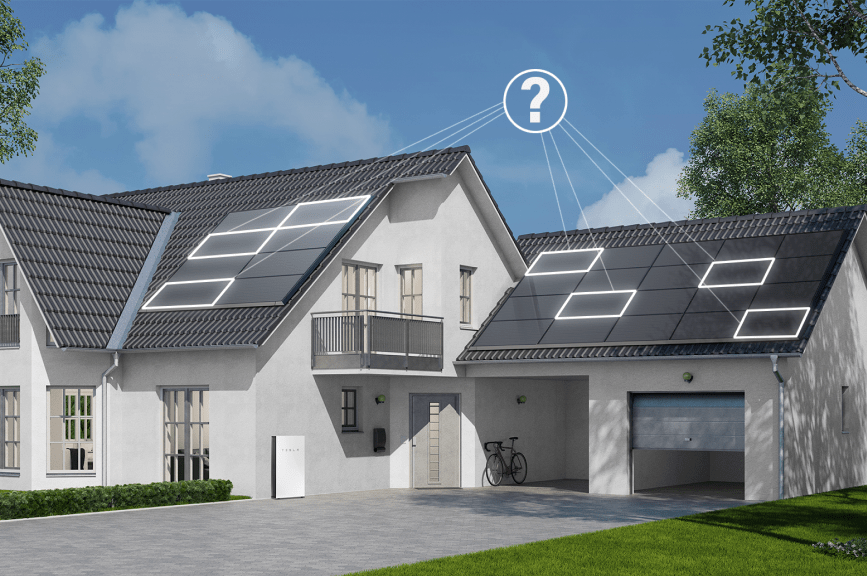

Every house — and the people and things inside — are different. The advice below will help you calculate approximately how many solar panels you might need. But only an expert will be able to take all factors into account and design the right solar system for you.
Why the Size of Your Solar System Matters
You’ll want to be confident in the size of your solar system before you install it. That’s because having a system that is too small might save you some money today but will leave you disappointed in how much energy you produce.
And installing a system too big will generate power you don’t need. That might sound appealing if your state has favorable net metering regulations in place, but many areas put a cap on the amount of energy you can send back to the grid. This means bigger isn’t always better — it can result in a loss of any excess power you produce.

To calculate how many solar panels to install, you’ll need to determine how much of your monthly energy use you want to offset with solar, as well as the size of your panels and the efficiency of your system.
And of course, how much space you actually have for panels. You may be able to install panels on your roof and/or the ground, but you must have space for them.
Factors that Determine How Many Solar Panels You Need
1. How much of your electricity usage do you want to offset with solar energy?
The “offset” is the amount of electricity your household draws from the grid that you want to replace with solar energy. While you might think that the answer to “how much do you want to offset with solar” is an obvious 100%, this typically isn’t the case.
In fact, the standard offset is around 80%, but it could be more or less depending on factors such as your budget, local regulations on the size of the system, whether your state allows net metering and the availability of a solar battery to store solar power for later use.


Measured in kilowatt-hours (kWh), your electricity usage is influenced by many things, including:
- The size of your house
- The number of people who live in your home
- Your major appliances (electric dryer, etc.)
- The climate where you live
- Other energy-intensive items, like an EV
To find out how much electricity you use, check your utility bill. To get a more accurate picture, try to find out how much electricity you use in a year. That way, you can account for seasonal changes in the weather or other outliers that can influence how much electricity you use month-to-month.
2. What size (wattage) solar panels should you choose?
A solar panel’s wattage, or power rating, measures how much electricity a panel can generate. The higher the wattage, the more power that’s produced. Most residential solar panels on the market today have an average output of about 250 to 400 watts.*
Each solar panel you buy will have a wattage, which you can then multiply by the number of panels to find your total system size.

3. How efficient will your system be?
A solar panel system’s efficiency — the ratio of what the system produces under “normal” conditions compared to what the system actually produces — tells you what your system is really doing at home.
Solar panels in different parts of the country will collect different amounts of energy — depending on both the local climate and relative location to the sun (latitude/longitude). The direction your roof faces or its angle will also impact how much solar energy your solar panels can collect. The time of year can affect available sunlight as well.
For example, here are some efficiency ratings in different U.S. cities, all measured with the same system.
As solar technology has progressed, panels have become more efficient, generating 25% more power from the same amount of sunlight, up to 20% efficiency from 15% efficiency in recent years.* For example, the solar panels installed by Sunnova dealers are on average 360W-370W, with an efficiency of at least 20%.
In the U.S., the average size for a home solar system is 10 kW. This table outlines how many panels you might need based on different watts.
The easiest way to account for all of these things is to use an online calculator, like this one from the National Renewable Energy Laboratory (NREL).
This calculator will ask for lots of information, some of which you might not know. But the more details you can provide, the more accurate the calculation will be.
The Formula for How Many Solar Panels You Will Need
Once you have an idea of the above information, you can better estimate how many solar panels you’ll need for your home.
Here’s how:
The number of panels you will need is the amount of solar electricity you want to create, divided by your ratios (refer to the ratio table above), divided by the solar panel power you plan to install.
For Example:
Location: Houston, Texas
- Electric energy consumption: 500 kWh/month (check your utility bill and take your yearly average)
- Yearly consumption: 6,000 kWh/year
- Amount of energy offset by solar: 80% of home electricity usage: 4,800 kWh/year
- Solar panel size: 370 watts
- Production ratio in Houston: 1.47
- Suggested system size: 3.27 kW
- Number of panels = suggested system size
(watts)/solar panel power (watts) = 3,265/370 = approx. nine solar panels.

Ready to see if your math checks out?
Contact Sunnova today for a no-obligation quote to see how many solar panels you need and how much you could potentially save on electricity.



